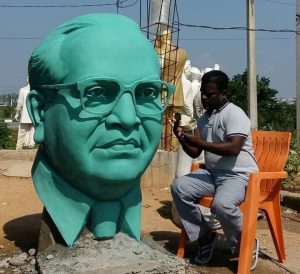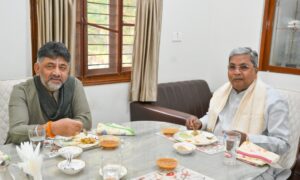
An artist is giving a final touch to Babasaheb Ambedkar’s statue. Picture: Social Media
As assembly elections are underway in four states namely Chhattisgarh, Madhya Pradesh, Mizoram and Rajasthan, the political parties are adopting a wide range of strategies to woo the voters. In three states, Bharatiya Janata Party (BJP) is running the governments. These are Chhattisgarh and Madhya Pradesh, Rajasthan. Indian National Congress is ruling in Mizoram which is dominated by the Scheduled Tribes (STs). In all three states, the Scheduled Castes (SCs) vote bank is extremely important for all parties because they constitute a
Percentage of Scheduled Castes Population – India, Chhattisgarh, Madhya Pradesh, Mizoram, and Rajasthan: 2001 and 2011
| Name of the State
|
Total | Rural | Urban | |||
| 2001 | 2011 | 2001 | 2011 | 2001 | 2011 | |
| INDIA | 16.2 | 16.6 | 17.9 | 18.5 | 11.8 | 12.6 |
| Madhya Pradesh | 15.2 | 15.6 | 15.6 | 15.7 | 14.0 | 15.3 |
| Rajasthan | 17.2 | 17.8 | 17.9 | 18.5 | 14.8 | 15.7 |
| Chhattisgarh | 11.6 | 12.8 | 11.4 | 12.8 | 12.4 | 12.8 |
Source: Census 2011
The percentage distribution of scheduled castes population to total population in India in 2011 explains that Punjab, Himachal Pradesh, West Bengal, Uttar Pradesh, and Haryana are among the top five states in India. The range of Scheduled Castes total population is 20 -32 percent in these states. The bottom five states/UTs by percentage of Scheduled Castes population are Mizoram, Meghalaya, Goa, Dadra & Nagar Haveli and Daman & Diu. As Mizoram comes under the bottom five states, we excluded it in the list.
It is heartening to note that there are no Scheduled Caste leaders in these states. Unlike Uttar Pradesh, the SC in these four states is highly fragmented. In order to grab the opportunity, Mayawati-led the Bahujan Samaj Party (BSP) decided to contest in Chhattisgarh in alliance with Ajit Jogi –led Chhattisgarh Janata Congress. After a bitter exit from Congress, Ajit Jogi formed a new party in Chhattisgarh. As Mayawati decided to venture in Chhattisgarh and Madhya Pradesh, she initially started negotiations with Congress which failed over the seat-sharing. When the negotiations failed, BSP Supremo collaborated with the newly formed party by a veteran administrator who expelled from Congress. It is noted that such collaboration is going to help the incumbent BJP and maybe Ajit Jogi will emerge as a kingmaker in a hung assembly. In Madhya Pradesh, Mayawati is contesting
As shown in the Census 2011, the Scheduled Castes constitute more than 17 percent in Rajasthan, 15 per cent in Madhya Pradesh and more than 12 percent in Chhattisgarh but they have a very small stake in power in these states. There is a sheer lack of Dalit leadership in these three states where the national parties are…
In the backdrop of Assembly elections…
In order to expand the horizon, Mayawati is contesting in Madhya Pradesh and Rajasthan separately where the SCs constitute 15 percent and 17 per cent of the total population. Both of these states are dominated by the BJP and Congress. Having 40 Members of Parliament, the BJP
Moreover, on paper, the BJP has a significant number of Dalit Lok Sabha members. Out of the 66 reserved Dalit Lok Sabha constituencies, the BJP won 60 percent – that is, 40 seats – in the 2014 elections. Almost 15 per cent of the BJP’s Lok Sabha strength consists of Dalit MPs elected from reserved seats. Having an impressive number in Parliament, BJP doesn’t have a prominent Dalit figure in these states. Mayawati is trying to lag the gap. Though it requires a prolonged strategy.
In the backdrop of the newly amended Scheduled Castes and Scheduled Tribes (Prevention of Atrocities) Act, the Upper Castes are raging against it especially in the poll-bound Madhya Pradesh. The move has led to fresh criticism by upper caste groups who feel that the NDA government has brought the amendments to woo Dalit voters and has ignored “concerns” of upper-caste and OBCs.
As reported by Economic Times, Rajasthan chief minister Vasundhara Raje waived off loans up to Rs 2 lakh benefitting over 20,000 Dalit and tribal entrepreneurs who have taken credit from state-owned Rajasthan SC/ST Development Finance Corporation in September 2018. Though Dalits are said to be not happy with the BJP government. There had been several cases of atrocities against them in past few years. But one can’t say how much these translate into votes.
Pre-election surveys conducted by Lokniti, Centre for the Study of Developing Societies, in the poll-bound states of Madhya Pradesh, Rajasthan and Chhattisgarh offer mixed news for the ruling Bharatiya Janata Party (BJP) and its main opponent, the Congress. They find both parties to be ahead in a state each, trailing in one and locked in a dead-heat in the third. JCC-BSP alliance damaging Cong more than BJP as the study articulated. As the non-parties are failed to contest collectively, the BJP can cope with the anti-incumbency factors in a couple of the boll-bund states where several cases of atrocities were reported in the recent past. Increasing atrocities and missing Dalit leadership in these states are no good sign for the inclusive development. It is evident that the Dalit vote is critical for the political parties which are contesting in the assembly elections. The rising tide of Dalit anger in various states has the potential to change the dominant political narrative.


















